|
Have a safe day!
Friday, July 9
3:30 p.m.
DIRECTOR'S COFFEE BREAK - 2nd Flr X-Over
4 p.m.
Joint Experimental-Theoretical Physics Seminar - One West
Speaker: Holger Meyer, Wichita State University
Title: Particle Production Results from the MIPP Experiment
Monday, July 12
THERE WILL BE NO PARTICLE ASTROPHYSICS SEMINAR THIS WEEK
3:30 p.m.
DIRECTOR'S COFFEE BREAK - 2nd Flr X-Over
4 p.m.
All Experimenters' Meeting - Curia II
Click here for NALCAL,
a weekly calendar with links to additional information.
Upcoming conferences |
|
For information about H1N1, visit Fermilab's flu information site.
|
|
Friday, July 9
- Breakfast: Chorizo burrito
- Italian vegetable soup
- Teriyaki chicken
- Southern fried chicken
- Mediterranean baked tilapia
- Eggplant parmesan panini
- Assorted sliced pizza
- Assorted sub sandwich
Wilson Hall Cafe Menu
|
|
Wednesday, July 16
Lunch
- Spicy sausage & cheese stuffed portobello mushroom
- Baby greens w/mango & marinated onions
- Fruit tart
Thursday, July 17
Dinner
- Booked
Chez Leon Menu
Call x3524 to make your reservation.
|
|
|
Piermaria Oddone reappointed to second term as director of Fermilab
 |
| Fermilab Director Pier Oddone |
The Fermi Research Alliance, LLC, Board of Directors announced Wednesday the reappointment of Piermaria Oddone to a second five-year term as director of Fermi National Accelerator Laboratory.
Robert J. Zimmer, President of the University of Chicago and chair of the Fermi Research Alliance, LLC board, announced the appointment, which has been approved by the U.S. Department of Energy. Fermi Research Alliance, LLC, formed in 2006, is a partnership with the University of Chicago and the Universities Research Association, which together manage Fermilab under a contract with the DOE.
The appointment was made with unanimous support of the Fermilab board, which voted to reappoint Oddone at its February 2010 meeting, following recommendations made by an ad hoc reappointment committee chaired by Neal Lane, member of the FRA Board of Directors and the Malcolm Gillis University Professor at Rice University.
"Pier has guided the laboratory with care and insight during his first term," said Zimmer. "His leadership and strategic vision are important for the future of Fermilab."
Oddone's second term commenced June 1, 2010.
During Oddone's tenure at Fermilab, the laboratory has pursued scientific programs in energy, intensity and cosmic frontiers of particle physics. The Tevatron, the most powerful proton-antiproton accelerator in the world, has consistently set new performance records for luminosity at the energy frontier. In addition, experiments conducted there have resulted in hundreds of published papers that expand understanding of fundamental physics. The laboratory also has developed world-leading programs in neutrino physics and particle astrophysics.
Read more
|
Call for applications for awards in URA Visiting Scholars Program
Universities Research Association, Inc. (URA) has announced a deadline of August 20 for the submission of applications for the fall 2010 cycle of awards in the URA Visiting Scholars Program at Fermilab. Successful applicants will be notified at the end of September.
These awards provide financial support for faculty and students from URA's 86 member universities to work at Fermilab for periods of up to one year. URA makes two rounds of awards each year, in the spring and fall. The application deadline for the spring 2011 cycle is February 18, 2011. Successful applicants will be notified at the end of March 2011.
Proposals may range from attendance at conferences or summer schools to year-long research stays. Support from this program can include transportation costs, local lodging expenses during a series of shorter visits or salary support during a longer visit. Individual awardees may receive up to a maximum of $50,000 in any 12-month period. URA has made a total of 86 awards since the beginning of 2008, including 19 awards conferred in May.
The program is a corporate commitment to Fermilab made by URA under the FRA contract with the Department of Energy. The 86 URA-member universities each contribute $5,000 a year for five years in support of joint Fermilab-URA research and education initiatives.
For details on the URA Visiting Scholars at Fermilab Program, including eligibility, application procedure, award administration and names of award recipients, visit the URA Visiting Scholars website. |
Unity Coat to sponsor music event Monday
Unity Coat, Fermilab's Disability Awareness Group, encourages Fermilab employees and users to relax with a lunchtime concert at noon on Monday, July 12, in Ramsey Auditorium. The concert will be performed by One Brick Short, a folk rock novelty band from Batavia.
|
Switch room repairs require ground-floor, atrium work
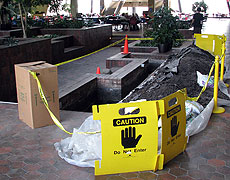 |
Work on the brick planter on the northwest side of the atrium won’t change the look of the foliage much, but it will improve your telephone service.
A Time and Materials crew will finish installing a liner in the planter and replacing the plants and flowers by Monday. The liner should alleviate intermittent leaks into the AT&T switch room on the ground floor beneath the planter.
Aurora-based IWS is overseeing repairs to the switch room, which serves as a phone service hub for the Fermilab Communication Office and surrounding towns. Drilling in the ceiling, which produces periodic noise, will finish by this evening. By Tuesday, crack sealing, painting and gutter repairs should be completed. |
|
The incredible shrinking proton that could rattle the physics world
From 80 beats, a Discover blog,
July 8, 2010
It wasn't supposed to be like this. The Higgs boson, dark matter, neutrinos-weird or poorly understood phenomena like these seemed the likely candidates to provide a surprise that changes particle physics. Not an old standby like the proton.
But the big story this week in Nature is that we might have been wrong all along in estimating something very basic about the humble proton: its size. A team from the Paul-Scherrer Institute in Switzerland that's been tackling this for a decade says its arduous measurements of the proton show it is 4 percent smaller than the previous best estimate. For something as simple as the size of a proton, one of the basic measurements upon with the standard model of particle physics is built, 4 percent is a vast expanse that could shake up quantum electrodynamics if it's true.
Read more
|
|
|
Rediscovering the weak force frontier
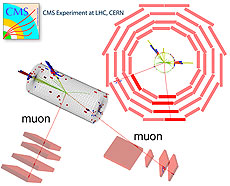 |
| Z bosons can decay into muon/antimuon pairs that will penetrate into the outer detector of CMS. Studying events like these is a crucial part in establishing that we understand our equipment. |
"How do you know, Daddy?" This is a question I'm often asked by my young son. As a scientist, I'm tickled to hear it. (As a Dad, it can get wearing.) "How do you know that?" is a question any reputable scientist has to be able to answer.
This is a question that CMS scientists will be asked frequently over the coming months and years. The first step in answering that question is to measure the phenomena of the Standard Model that are very well established. CMS has observed well known particles, as well as the ubiquitous jets, which are the debris associated with knocking quarks and gluons out of the LHC's proton beams. The strong nuclear force, the strongest of all of the subatomic forces, governs the creation of these particles.
Today's article features the observation of the W and Z bosons in the CMS detector. These particles govern the behavior of the weak nuclear force, the weakest of the known forces. Physicists can most easily observe the W and Z bosons by their decay into leptons, including the electron and the more exotic muons and neutrinos.
W bosons are the more commonly produced boson. About 100 are observed. Half of those decay into an electron and half into a muon. In both cases, the decay is accompanied with the corresponding neutrino. Z bosons are created approximately one tenth as often, and are equally likely to decay into an electron/antimatter-electron pair or the muon counterpart.
Physicists know the range of allowed values for the W and Z boson masses to great precision. They can accurately predict how often the bosons should be produced to 5 percent. Being able to show that we can reproduce these known and expected values will go a long way toward answering any question about how we're sure our observations are accurate.
-- Don Lincoln
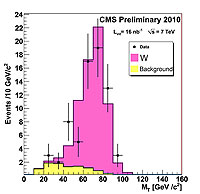 |
| When looking for W bosons that decay into a muon and a neutrino, we compare the observed data (black points) to the prediction (colored region.) The pink region is the prediction for W production, while the yellow region includes events that look like W bosons, but aren't. The fact that there is so much more pink area illustrates that our measurement is a rather pure sample of W bosons, with little contamination. Figure adapted from here. |
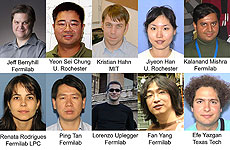 |
| An effort of this magnitude requires the collaboration of many people, with just a subset highlighted here. Not pictured: Anirban Saha, Tata Institute of Fundamental Research. |
|
Wedding
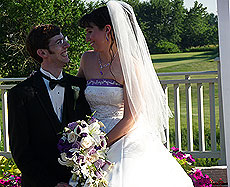 |
| Congratulations to Aria (Meyhoefer) and Aron Soha, both Fermilab employees in the Particle Physics Division, who wed Saturday, July 3, 2010. |
|
|
July 2-7
- Eight stores provided ~95.75 hours of luminosity
- CHL personnel overhauled Pbar dry engine
- I- Source problems
- FESS resolved many high-temperature problems
- Beam power reduction began
- Recycler vacuum cascade caused stash loss
- TeV personnel conduct studies
*The Integrated Luminosity for the period from 6/28/10 to 7/5/10 was 59.03 inverse picobarns.
NuMI reported receiving 8.37E18 protons on target during this same period.
Read the Current Accelerator Update
Read the Early Bird Report
View the Tevatron Luminosity Charts
|
|